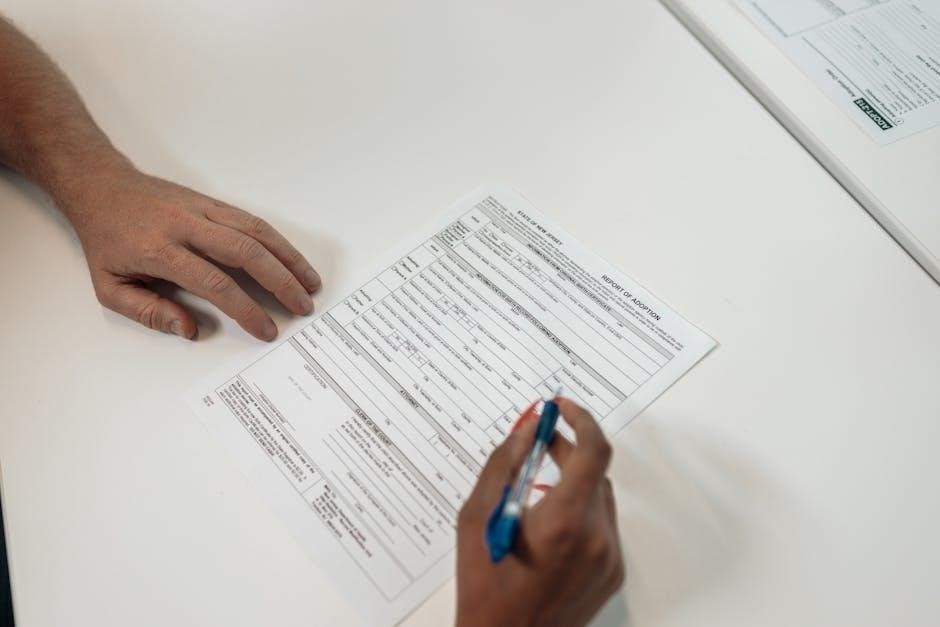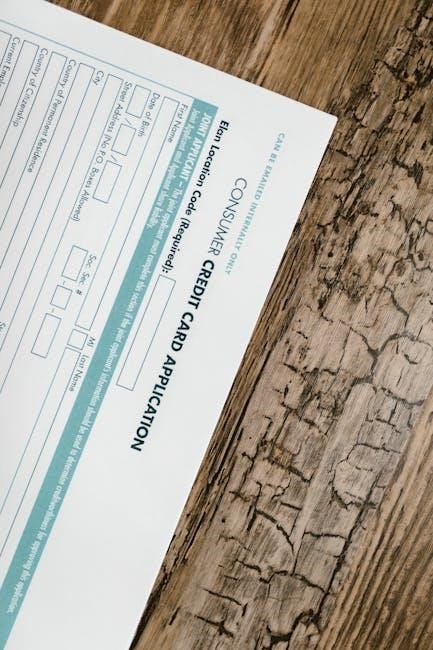The Stolen Generation refers to Aboriginal and Torres Strait Islander children forcibly removed from their families during the 1900s-1970s under government assimilation policies, causing profound trauma and intergenerational impact.
1.1 Definition and Historical Context
The Stolen Generation refers to Aboriginal and Torres Strait Islander children forcibly removed from their families between the early 20th century and 1970s under assimilation policies. These removals were sanctioned by government authorities, often without parental consent, aiming to erase Indigenous cultures. Children were placed in institutions or non-Indigenous families, leading to cultural disconnection and long-lasting trauma. This historical injustice is now addressed through redress schemes, including Queensland’s application process, which seeks to provide acknowledgment and support to affected survivors and their families.
1.2 Impact of Forced Removal Policies
The forced removal of Indigenous children caused profound and lasting effects on individuals, families, and communities. Many survivors experienced emotional trauma, cultural dislocation, and social alienation. Families were fractured, and connections to heritage were severed. Intergenerational impacts persist, affecting mental health, education, and economic opportunities. The policies also eroded Indigenous cultures and languages, leaving a legacy of inequality. These effects are central to the redress efforts, including Queensland’s application process, aimed at providing acknowledgment and support to affected survivors and their descendants.

Background of the Stolen Generation in Queensland
Queensland’s Stolen Generation stems from historical government policies forcibly removing Aboriginal and Torres Strait Islander children from their families, causing intergenerational trauma and cultural disruption.
2.1 Historical Government Policies in QLD
Queensland’s Stolen Generation resulted from government policies enforcing the forced removal of Aboriginal and Torres Strait Islander children from their families during the early 20th century to the 1970s. These policies, driven by assimilation ideologies, aimed to erase Indigenous culture and integrate children into non-Indigenous society. Authorities, including police and welfare officers, often removed children without consent, placing them in missions or foster care. This traumatic era caused profound intergenerational harm, disrupting families, cultures, and communities, with lasting effects still felt today.
2.2 Number of Affected Individuals and Families
Estimates suggest that between one in three and one in ten Aboriginal and Torres Strait Islander children in Queensland were forcibly removed from their families. This resulted in thousands of individuals and families being impacted, with the trauma passed down through generations; The exact number is difficult to determine due to incomplete records, but the emotional and cultural toll remains profound. Many survivors and their descendants continue to seek justice and healing through redress schemes and support services.

Purpose of the Application Form
The application form enables eligible individuals to formally apply for financial compensation and wellbeing support under the Stolen Generations Redress Scheme in Queensland.
3.1 Overview of the Application Process
The application process begins with obtaining the official form from the Queensland Government website or via the dedicated support team. Applicants must provide personal and historical details, including evidence of Aboriginal or Torres Strait Islander descent and documentation proving forced removal. Completed forms are submitted online or by mail to the designated office for review. A dedicated assistance team is available to guide applicants through the process, ensuring all requirements are met efficiently.
3.2 Benefits and Support Available
Eligible applicants under the Stolen Generations Redress Scheme in Queensland receive financial compensation to acknowledge past traumas. Additional benefits include access to health and counselling services, addressing emotional and psychological impacts. Community and cultural support programs are also available to reconnect survivors with their heritage. A dedicated assistance team provides guidance throughout the application process, ensuring applicants receive the support they need. These benefits aim to provide some measure of justice and healing for the Stolen Generations and their families.

Eligibility Criteria for the Application
Applicants must be of Aboriginal or Torres Strait Islander descent, forcibly removed as minors, and meet specific criteria outlined in the Queensland redress scheme guidelines.
4.1 Who Can Apply?
Individuals of Aboriginal or Torres Strait Islander descent who were forcibly removed from their families as minors under historical government policies are eligible to apply. Applicants must provide evidence of their removal and Indigenous heritage. Survivors can apply directly, or in cases of incapacity, a legal representative or family member may submit on their behalf. The scheme also considers applications for deceased individuals, ensuring their descendants can access benefits. A dedicated support team assists applicants throughout the process, ensuring accessibility and clarity for all eligible participants.
4.2 Required Documentation and Evidence
To apply, individuals must provide personal identification, proof of Aboriginal or Torres Strait Islander descent, and evidence of forced removal. Documents may include birth certificates, historical records, or letters from Indigenous organizations. Witness statements or institutional records can support claims of removal. Applicants without standard documents may submit alternative evidence, such as statutory declarations or community testimonials. The dedicated support team assists in gathering and verifying these materials, ensuring accessibility for all eligible applicants.

Application Process Step-by-Step
Obtain the application form online or via the dedicated hotline. Fill it accurately, attach required documents, and submit. Support teams are available to assist applicants.
5.1 Obtaining the Application Form
The application form can be downloaded from the Queensland Government’s official website or obtained by contacting the dedicated support team at 1800 566 111. Applicants may also request a physical copy via mail. Additionally, community centers and legal aid offices often provide access to the form. Ensure the correct version is used, as outdated forms may delay processing. Visit www.qld.gov.au/reparations for the most updated version.
5.2 Filling Out the Form Correctly
Accurately completing the application form is crucial for a successful submission. Ensure all sections are filled out, including personal details, evidence of Aboriginal or Torres Strait Islander descent, and documentation of forced removal. Use block letters and avoid abbreviations. Attach required certified documents, such as birth certificates and statutory declarations. Double-check for errors or missing information before submission. If unsure, seek assistance from the dedicated support team or legal advisors. Incomplete or incorrect forms may result in delays or rejection.
5.3 Submitting the Application
Once the form is completed, submit it via the approved methods: online, mail, or in-person at designated offices. Ensure all required documents, such as certified copies of identification and proof of removal, are enclosed. Retain copies for personal records. Applications must be received by the specified deadline to be processed. For assistance, contact the dedicated support team at 1800 566 111. Timely submission is crucial to avoid delays or rejection. Ensure the application is signed and dated as required.
Required Documents and Evidence
Applicants must provide personal identification, proof of Aboriginal or Torres Strait Islander descent, and evidence of forced removal, such as historical records or statutory declarations.
6.1 Personal Identification Documents
Applicants must submit valid personal identification, such as a birth certificate, passport, or government-issued ID, to verify their identity and eligibility for the Stolen Generations redress scheme.
These documents are essential to confirm the applicant’s personal details and ensure the application is processed accurately and securely.
Replacement services for lost or damaged documents may be available, particularly for those affected by declared disasters, ensuring accessibility for all eligible applicants.
6.2 Proof of Aboriginal or Torres Strait Islander Descent
Applicants must provide documentation confirming their Aboriginal or Torres Strait Islander heritage, such as birth certificates, family historical records, or letters from recognized Indigenous organizations.
Descendant verification may involve tribal or community elders’ statements or genealogical research to establish lineage and cultural connection.
For those with limited documentation, alternative evidence, such as adoption papers or historical records, may be accepted to validate their Indigenous identity.
6.3 Evidence of Forced Removal
Evidence of forced removal may include official records, such as foster care documents, adoption papers, or institutional records, confirming the applicant’s removal as a child.
Statutory declarations from family members or community elders detailing the circumstances of removal can also be submitted if formal documents are unavailable.
Additionally, historical records from government agencies or welfare organizations involved in the removal process may serve as supporting evidence for the application.
Support and Resources for Applicants
Dedicated assistance teams provide guidance, while legal and advocacy services help navigate the process. Community and cultural support are also available to aid applicants throughout their journey.
7.1 Dedicated Assistance Teams
Dedicated assistance teams are available to guide applicants through the Stolen Generations redress process. These teams provide personalized support, answering questions and assisting with form completion. They ensure applicants understand eligibility criteria and required documentation. The teams operate Monday to Friday, 9am to 5pm AEST, and can be contacted via phone or email. Their role is to simplify the application process, addressing concerns and offering emotional support to those affected by historical forced removals. This support is crucial in helping survivors navigate the complexities of the redress scheme.
7.2 Legal and Advocacy Services
Legal and advocacy services are available to assist Stolen Generations survivors with their applications. These services provide free or low-cost legal advice, helping applicants navigate the redress process. Lawyers and advocates specialize in understanding the historical and emotional complexities of these cases, ensuring applicants’ rights are protected. They also assist with gathering evidence, completing forms, and representing clients in class action lawsuits. These services aim to empower survivors, addressing systemic injustices and supporting their pursuit of justice and reparations for the trauma endured. Legal advocates play a crucial role in simplifying the application process and advocating for fair outcomes.
7.4 Community and Cultural Support
Community and cultural support services play a vital role in assisting Stolen Generations survivors throughout the application process. These services provide emotional, cultural, and practical support, helping survivors reconnect with their heritage and community. Organizations offer counseling, traditional healing programs, and cultural camps to address the intergenerational trauma. Dedicated teams also facilitate access to elders and community leaders, ensuring cultural knowledge and practices are preserved. Additionally, community events and workshops are held to educate and empower survivors, fostering a sense of belonging and resilience. These initiatives are essential in supporting applicants’ wellbeing and dignity during their journey toward redress.

Financial and Wellbeing Packages
The Stolen Generations Redress Scheme offers financial compensation and access to health services, addressing the trauma and suffering caused by forced removals, promoting healing and dignity.
8.1 Monetary Compensation
The Stolen Generations Redress Scheme provides monetary compensation to eligible survivors, acknowledging the harm caused by forced removals. Payments are determined based on individual circumstances, with amounts varying to reflect the severity of trauma. This financial support aims to assist survivors in rebuilding their lives and accessing essential services. The scheme also offers additional wellbeing packages, ensuring holistic support for healing and recovery. Applicants can seek guidance from dedicated assistance teams to navigate the process and understand their entitlements. Compensation is a key component of the redress scheme, offering tangible recognition of past injustices.
8.2 Access to Health and Counselling Services
Eligible applicants under the Stolen Generations Redress Scheme gain access to specialized health and counselling services. These services address the long-term emotional and psychological impacts of forced removal. Survivors can access culturally appropriate support, including trauma-informed counselling and mental health programs. Additionally, the scheme connects individuals with community-based health services, ensuring they receive holistic care. These resources aim to support survivors in their healing journey, fostering resilience and well-being. The scheme emphasizes the importance of culturally sensitive care to meet the unique needs of Stolen Generations members.

Legal Considerations and Class Actions
Legal considerations involve class actions, lawsuits, and redress schemes addressing historical injustices. The Queensland government faces legal challenges for racial discrimination and systemic failures affecting Stolen Generations survivors.
9.1 Class Action Lawsuits in QLD
Queensland faces significant class action lawsuits led by First Nations families alleging racial discrimination and systemic failures; Over 100 families are suing the state, highlighting generational trauma and abuse. The case, spearheaded by Brett Harold Gunning and Madison May Burns, accuses the child safety department of modern stolen generation practices. These lawsuits seek justice and compensation for survivors, addressing historical and ongoing injustices perpetuated by government policies and practices.
9.2 Role of Legal Advisors
Legal advisors play a crucial role in assisting Stolen Generations survivors with their applications and claims. They provide expert guidance on navigating the legal complexities of redress schemes and class actions. Advisors help gather evidence, interpret policies, and ensure applicants understand their rights. They also represent clients in court, advocating for fair compensation and justice. Their expertise is vital in addressing the historical injustices faced by survivors, ensuring their voices are heard and their claims are processed fairly and efficiently.

Timeline and Deadlines
Applications for Queensland’s Stolen Generations redress scheme are open until 31 August 2027, with processing times varying based on the complexity of each case.
10.1 Application Submission Deadlines
Applications for Queensland’s Stolen Generations redress scheme must be submitted by 31 August 2027. Late submissions may not be accepted unless exceptional circumstances are proven. Applicants are encouraged to apply early to avoid delays. Forms can be submitted online or via mail, with detailed instructions provided on the Queensland Government website. Dedicated support teams are available to assist with the process. Ensure all required documents are included to avoid processing delays. Extensions may be granted in rare cases, but applicants must request this in writing before the deadline.
10.2 Processing Time for Applications
Processing times for Stolen Generations applications in Queensland typically range from 6 to 9 months. Delays may occur if applications are incomplete or require additional evidence. Applicants are urged to submit all required documents upfront to expedite the process. The Queensland Government prioritizes these cases to ensure timely resolution. Applicants can contact the dedicated support team on 1800 566 111 for updates or to address concerns. Once submitted, applicants will receive confirmation, and regular updates will be provided throughout the review period.

Challenges and Controversies
Applicants face difficulties gathering evidence, critics question the scheme’s adequacy, and processing delays frustrate survivors, highlighting systemic barriers and ongoing injustices for Stolen Generations in Queensland.
11.1 Difficulties in Gathering Evidence
Gathering evidence for Stolen Generations applications is challenging due to destroyed or lost records, passage of time, and lack of documentation. Survivors often rely on oral histories or fragmented information, complicating proof of removal. Emotional trauma and reluctance to revisit painful memories further hinder the process. Additionally, inconsistencies in historical records and the need for corroborating evidence create barriers, making it difficult for applicants to meet eligibility criteria despite their legitimate claims.
11.2 Criticisms of the Redress Scheme
The Queensland Stolen Generations Redress Scheme has faced criticism for its limited scope and perceived inadequacy in addressing the scale of trauma experienced. Some argue the financial compensation offered is insufficient compared to the lifelong harm caused by forced removals. Additionally, the complex application process and stringent evidence requirements disproportionately affect elderly survivors, many of whom face barriers in gathering necessary documentation. Critics also highlight delays in processing applications, further exacerbating the emotional toll on survivors and their families. These issues underscore the need for a more equitable and compassionate approach to redress.

Success Stories and Testimonies
Many Stolen Generations survivors have shared powerful stories of resilience and healing through the Redress Scheme, highlighting its role in reconnecting families and restoring cultural heritage.
12.1 Personal Stories of Survivors
Survivors of the Stolen Generation share heart-wrenching accounts of separation and resilience. Many describe the emotional toll of forced removal and the lifelong struggle to reconnect with their culture. Personal testimonies highlight the importance of the Redress Scheme in providing acknowledgment and support. For example, Donna Meehan’s story illustrates the profound impact of these policies and the healing power of recognition. These stories underscore the strength of survivors and their families, emphasizing the need for continued support and justice.
12.2 Impact of the Redress Scheme
The Redress Scheme has brought significant relief to Stolen Generation survivors, offering financial compensation and access to health services. It acknowledges past injustices, fostering healing and reconciliation. Survivors report that the scheme helps rebuild connections to their culture and community. While challenges remain, the initiative provides a pathway toward justice and recognition, aiding survivors in moving forward with dignity.
The Stolen Generation application form in Queensland is a vital tool for addressing historical injustices, providing closure, and supporting survivors through redress and recognition of their experiences.
13.1 Importance of the Application Form
The application form is a critical pathway for Stolen Generations survivors to access financial compensation, health services, and cultural support. It ensures formal recognition of their traumatic experiences, facilitating healing and justice. By providing a structured process, the form helps survivors navigate the complexities of redress, preserving their histories and identities. It also enables the government to address historical injustices systematically, offering a tangible step toward reconciliation and acknowledging the profound impact of forced removals on individuals and communities.
13.2 Future Prospects for Stolen Generations
The future holds promise for Stolen Generations survivors through ongoing support and reconciliation efforts. Dedicated assistance teams and legal services continue to aid applicants, ensuring access to justice and reparations. Community and cultural programs foster healing and connection to heritage. Educational initiatives raise awareness, preventing similar injustices. The application form serves as a gateway to these opportunities, empowering survivors to reclaim their identities and build a brighter future for themselves and their descendants, while promoting societal acknowledgment and healing.
